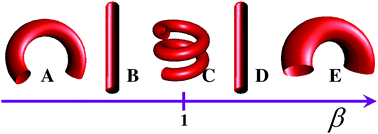Dissipative particle dynamics simulations on overcharged cylindrical polyelectrolyte brushes with multivalent counterions
Abstract
Employing a dissipative particle dynamics (DPD) approach, we investigate the overcharging behaviors of a cylindrical polyelectrolyte brush (CPB) in the presence of multivalent counterions. The conformational change of the CPB is considered with the increasing concentration of multivalent counterions. We gain insight into the re-expansion mechanism of the CPB by examining various parameters. The influence of the overcharging on the possibility of lyotropic behavior for the CPB is discussed based on the ratio of the persistence length (lp) to the diameter of the CPB (d). Our simulations demonstrate that the CPB can exhibit a horseshoe–rod–helix–rod–horseshoe conformational change from the collapse to the re-expansion regimes. The excluded-volume effects of the multivalent counterions and the monovalent positive ions absorbed by the CPB in the re-expansion regime increase its size, causing a re-expansion of the brush. Our simulations show that the increase of the ratio lp/d turns to be much slower in the expansion regime, demonstrating that excess addition of the salt with multivalent counterions does not improve efficiently the lyotropic behavior of the CPB. These findings provide guidelines for tailoring the structures of the CPB and thereby controlling the interaction between the CPB and couterions.


 Please wait while we load your content...
Please wait while we load your content...